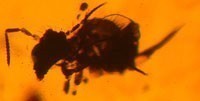Saturday, July 29, 2006
New genus of Collembola named after Grinnell College and alumna
Grinnell, Iowa - A Grinnell College biology professor has discovered a new genus of an extinct branch of the Collembola, a group of small arthropods partly responsible for the nutritious soil farmers enjoy.
The genus, located in amber discovered in Myanmar (Burma), is a relative of the more than 4,000 species of Collembola, also called springtails, found throughout the world today.
"The Collembola is a group often ignored and mostly misunderstood," said Ken Christiansen, professor emeritus of biology at Grinnell College, Grinnell, Iowa, and a leading researcher of Collembola worldwide. "I feel certain that if Collembola were the size of cats there would be whole zoos devoted to them because they are so weird and varied. They are among the most numerous arthropods on earth's surface, with as many as a trillion in an acre of soil."
..."I feel very honored to have a species named after me," said Ventis. "I think that the descriptions ... will shed new light on questions about mass extinctions and about the evolution of Collembola." [cretaceous]
-------
Featured book: George Poinar's "Lebanese Amber: The Oldest Insect Ecosystem in Fossilized Resin" (Amazon UK | US)
Books on Amber Fossils from the Science and Evolution Bookshop: UK | US
technorati tags: grinnell, iowa, biology, collembola, arthropods, amber, burma, cretaceous, evolution
Add to: CiteUlike | Connotea | Del.icio.us | Digg | Furl | Newsvine | Reddit | Yahoo
